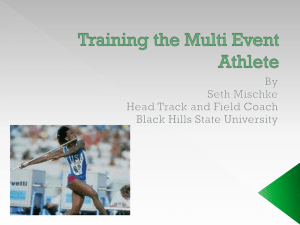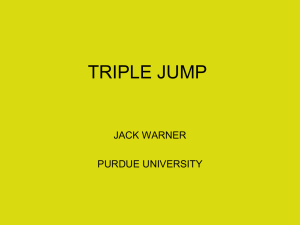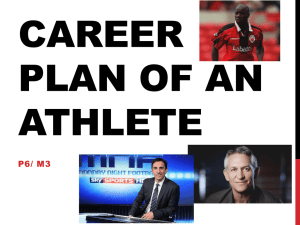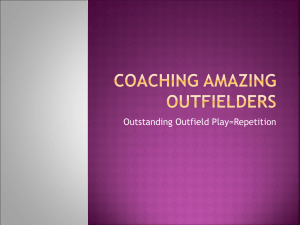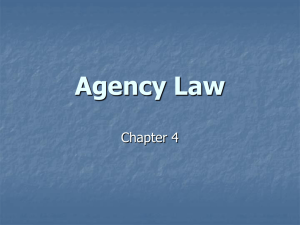Long Jump and Triple Jump Presentation
advertisement
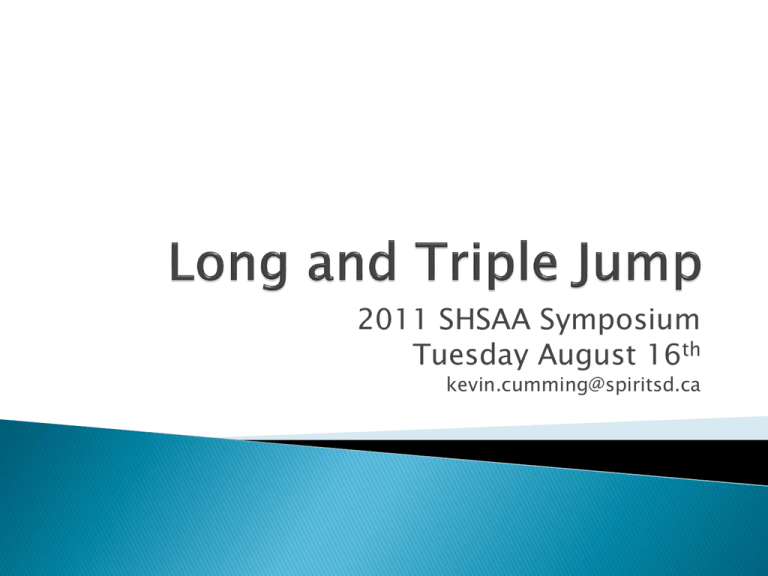
2011 SHSAA Symposium Tuesday August 16th kevin.cumming@spiritsd.ca 1. 2. 3. 4. Approach Take Off Flight Landing Having a consistent approach is extremely important There are different ways to start an approach Depending on the athlete, one method may work better than another ◦ ◦ ◦ ◦ Crouch Roll Over “Cruise in” “Skip in” It is critical that the athlete always starts the approach the same way ◦ For this reason, a crouch or a roll-over can lead to a more consistent approach compared to a “cruise in” or a “skip in” ◦ When adjusting an athlete’s approach, make sure that the athlete is starting consistently or the adjustment may not work Length should be such that the athlete is at full speed and not slowing down at the board ◦ 14 – 18 strides is pretty “normal” until athletes get more experienced Things to look for in a good approach ◦ ◦ ◦ ◦ Consistent start – push out hard Acceleration throughout the approach Control at the board A good body position At take off, the athlete should be “tall” – not bending forward at the waist, not leaning back ◦ A penultimate step (second last step) This is a slightly shorter step that helps the athlete lowers a bit that helps them “load” on their take off (we will talk about this during the take off section) Drills ◦ Full approaches with take-off’s (not necessarily landings) Video analysis ◦ ◦ ◦ ◦ Different types of starts Driving out of the starting position Body position Penultimate step Actually consists of the last two steps The penultimate (second last step) is critical for a good take off It should be slightly shorter and the hips should lower a bit To do this, the athlete should try to: ◦ Plant a FLAT foot ◦ Put their foot down a little quicker than normal They should NOT: The sound of the plant should not be “slappy” ◦ Try to lower by bending forward, it should be a “lower”ing The penultimate step allows the athlete to “load” their take off leg and PUSH off the ground The take off foot should be planted FLAT ◦ A “toe” plant can lead to shin pain and injury as well as heel bruising (when the heel slams down) ◦ Too much of a “rolling” plant (heel – to – toe) doesn’t allow the athlete to extend off the ground and can also lead to heel bruising The take off plant should be slightly in front of the body ◦ Too far in front can lead to a block and a loss of speed ◦ A plant too far underneath or behind the athlete results in a “flat” jump Think of the plant as a “catch and push” The athlete should also be extending off of the plant after they catch and push The focus should be on running off the board It is NOT a bad thing to spend time on the board, you can not push off the ground if you are not in contact with it!! Drills ◦ High skips Full extension off the leg is necessary Low blocking of the free leg (knee below the hip) Foot out in front ◦ “One steppers” Take offs on the jumping foot each time Blocking the knee drive as well Land on the free leg When putting down the free leg, it should cycle like riding a bicycle (try to avoid a jerking “forward and back” motion) “Three steppers” ◦ “Run run run jump” drill still focusing on the same things as the one step drills ◦ At this point, athletes can also start working on their penultimate step as well ◦ The arms are important as well, there should be an arm drive and when the drive knee lowers, the OTHER arm can cycle forward This arm circles with the elbow at about 90 degrees ◦ These drills can also be done over hurdles Vary the distance between and height of the hurdles 2, 4, 6, 8 etc .... stride approaches. ◦ When starting practices, athletes should be able to “master” the penultimate step and the extension before moving further back ◦ 2 stride drills are critical to get the “lowering” of the penultimate as opposed to bending forward for the penultimate. ◦ The athlete will be able to feel the “loading” of the jump with these lower speed drills and can really focus on the “catch and push” ◦ The athlete should also be able to feel a stretch in the hip of the take off leg, that will ensure full extension. Video analysis ◦ High skips, one-steppers, three-steppers ◦ Penultimate step from short approach ◦ Penultimate step from full approach Shoulders ◦ Shoulders should always be above the hips, even when getting into landing position Arms ◦ When arms move, legs move If an athlete is getting into the landing position too soon, sometimes making an adjustment to the arms can help (they are easier to control) Hang vs Hitch Kick ◦ In long jump, there is a great deal of forward rotation created at take off ◦ Both a hang and a hitch kick (running in the air) can help combat this forward rotation to help increase distance ◦ Athletes that are more experienced and faster will most likely do a hitch kick but for less experienced athletes, a hang is more than adequate Video analysis Athletes should be focusing on bringing knees and feet UP to land, not pushing them into the sand Hands are important, they should be high in the air and then coming forward and down past the feet Heels hit the sand first, then the knees collapse and feet clear up and out of the sand Landing drills (video) 1. Standing long jump Extend, drive hands up, bring knees UP, land in squat Same as above, but focus on heels coming up to butt before knees come up and land in squat 2. Heels to butt 3. Hold extension, heels to butt 4. Full landing Heels hit, knees bend and clear feet up and out, NOT just out. Can be done off of a box or bench as well to work on “hang time” As everyone knows, there are three phases: the hop, the step and the jump An ineffective hop can have a negative effect on both the step and the jump phases Things to watch for in all three phases: ◦ Foot contact (should be flat and slightly in front) ◦ Shoulder position (should be over top of the hips) ◦ Hip angle (pelvis should not be tilted backward) Like in long jump, contact with the ground should be “catch and push” as opposed to a “pulling” motion Setting up for the hop off of the approach is very important The approach should be run with high knees and the athlete should be encouraged to really extend forward off of the board, not up as in long jump ◦ There should be a stretch in the hip ◦ The athlete needs to feel their foot behind them before they finish their take off There is NO penultimate step in a triple jump approach so there should be no radical lowering before the board The free leg (leg not in contact with the ground) has a great deal to do with an effective hop A free leg that moves aggressively back and forth can really change the angle of the hips and thus have a detrimental effect on the end of the hop A free leg that CYCLES allows the hips to “come through” the hop and allows the second contact to be flat and slightly in front which allows the athlete to “catch and push” The cycling motion is a result of the running motion, thus, if the athlete runs well the free leg cycle will come easier The cycling motion helps control the rotation and slow down the jumping leg allowing for the athlete to get a longer hop It is okay for athletes to spend some time on the ground, especially during triple jump drills Athletes that are “toey” have a much higher chance of getting injured than an athlete that has their foot dorsiflexed (toes pulled up) The second phase (the step) is probably the phase that most young athletes have the most trouble with This is mostly due to the ending of the hop, the athlete needs to feel what it is like to JUMP off the end of the hop, not just end the motion In the step phase, the athlete should be trying to produce a force downward, their horizontal velocity will allow them to get forward through the jump Any attempt to jump forward usually has a negative effect on hip position and ends up in a short step phase The key is swing the free leg forward (sometimes you can cue that the knee needs to swing forward) Then it is another catch and push Again, focus on keeping balanced with the shoulders above the hips will help with the jump Again, the force should be applied down, letting the forward momentum carry the athlete into the pit A hang is most effective, a hitch kick is unnecessary The same landing drills that we talked about in long jump can also be used in triple jump Hopping Drills ◦ Should be done on both legs ◦ Free leg should be held slightly in front, but should be relaxed ◦ ◦ ◦ ◦ ◦ ◦ ◦ Eventually the free leg will cycle in a natural motion Do not focus on jumping forward, focus on jumping up! For inexperienced athletes only do 5-6 in a row Flat footed contact with a push Posture!! (shoulders and hips) Extend off the ground Can be done from a two footed start Eventually the hops can get bigger but start with them only a few feet long Step Drills ◦ ◦ ◦ ◦ Sometimes just called bounding Focus on posture and the catch and push Again, force should be directed downward Swing the knee forward from step to step The foot should clear above the ankle when coming forward ◦ Start from a two foot start to help promote power generation and the pushing motion Transition Drills ◦ To help transition from hop to step ◦ Long skips To get extension on their take off Eventually these can become less rigid and “flow” into a double-double drill ◦ Double double (RR LL RR LL etc) Hop – hop step drills ◦ For the athlete to get the feeling of jumping off the end of the hop. Any of theses drills can be done with boxes as well, either into the pit or from box to box ◦ These boxes should be relatively low though (2 – 4 inches) Knee height might be low during drills but that is okay, a high knee is usually the result of the stretch reflex in the hip and the horizontal speed that has been generated in the approach These drills should be done off of little speed to help strengthen the legs and to help teach the pushing motion but as the season (and athlete’s familiarity to the drill) progresses, they can be done from 2,4,6 etc... strides Video analysis ◦ ◦ ◦ ◦ Long skips Hop drills Step drills Full jumps Good free leg, bad free leg Swinging into step Take off for jump phase
